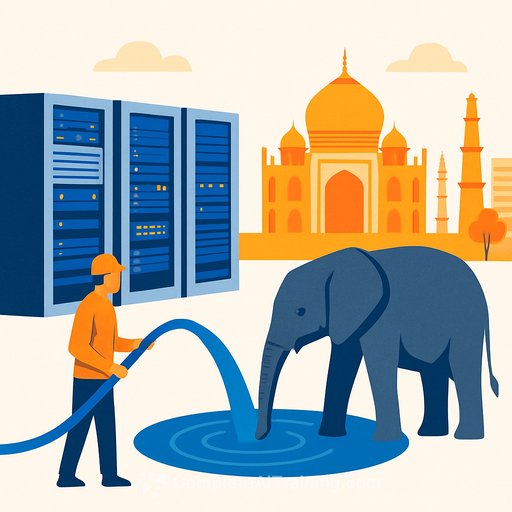AI's Water Footprint in India's Cities - and How Tech Also Helps Elephants
AI needs compute. Compute needs cooling. Cooling needs water. That chain is stressing water-scarce Indian cities as data centers expand to serve training and inference at scale.
The upside: the same tools can protect ecosystems. Projects use machine learning to monitor wildlife, reduce poaching, and cut human-elephant conflict. The choice isn't AI versus nature. It's how we build and where we deploy.
Why data centers use so much water
Servers convert electricity into heat. Facilities remove that heat with evaporative cooling, chilled water loops, or hybrid systems. Each design trades water for energy and cost.
A key metric is Water Usage Effectiveness (WUE), measured in liters per kWh delivered to IT load. Lower is better. Facilities can push WUE down with air-side economization, heat reuse, and non-potable sources, but location and climate still drive the baseline.
Training frontier-scale models and running large inference fleets compresses peak loads. Peaks matter: they dictate cooling capacity and water draw, especially during hot months and heatwaves.
Can India's cities cope?
Urban India already faces chronic water stress in places like Bengaluru, Chennai, and Delhi. Groundwater is overdrawn, surface reservoirs fluctuate, and tanker markets spike during dry spells.
Placing water-intensive data centers in stressed basins compounds risk for households and industry. The smart move is to align siting, cooling, and water sourcing with local hydrology and grid constraints.
Practical actions for policy, utilities, and cloud providers
- Site selection: Prefer low water-stress basins and cooler microclimates. Require basin-level risk assessments and community water impact studies.
- Cooling choices: Favor air-cooled, dry coolers, or hybrid systems with seasonal switching. Push for immersion/liquid cooling in high-density racks to reduce total facility water needs.
- Water sourcing: Use reclaimed or brackish water where feasible. Avoid potable sources. Mandate on-site storage for peak days and heatwaves.
- Water circularity: Close loops with treatment and reuse of blowdown water. Capture condensate and rainwater. Publish WUE and withdrawal/consumption data quarterly.
- Heat reuse: Pipe low-grade heat to district heating, greenhouses, or industrial processes to cut cooling load.
- Grid coordination: Align high-load windows with cooler night hours and renewable generation peaks to ease both water and energy stress.
What AI teams can do today
- Model efficiency: Use smaller architectures, distillation, pruning, and quantization for inference. Cache results and batch requests to smooth peaks.
- Training tactics: Schedule runs in cooler hours and seasons. Use data centers with published low WUE and non-potable sourcing. Track kWh, PUE, and WUE per run.
- Hardware choices: Prefer accelerators and memory configs that deliver higher tokens/W and tokens/L of water consumed.
- Observability: Include water and energy metrics in MLOps dashboards. Set budgets per project and enforce them with gating.
Standards and transparency that help
- Mandate reporting: Require public PUE/WUE, withdrawals vs. consumption, and water source mix for all hyperscale and colocation facilities.
- Procurement levers: Government and enterprise contracts should award points for low WUE, non-potable sourcing, and basin-appropriate siting.
- Independent audits: Annual third-party verification of water data and community impact commitments.
The other side of the ledger: AI saving elephants
Computer vision and acoustics cut detection time for poaching and conflict events from hours to minutes. Camera traps flag people and vehicles on protected corridors. Acoustic sensors pick up gunshots or distress calls through dense forests.
Faster detection means rangers respond sooner, and communities get alerts before elephants reach farms. That reduces casualties and crop loss without escalating force. It's a clear example of targeted AI delivering high ecological return per watt.
What good looks like for Indian deployments
- Co-location with circular water: Place facilities next to wastewater treatment plants or desalination units with closed-loop reuse.
- Heat maps before hardware: Use basin-level water risk tools before committing to land or power agreements.
- Pilot, then scale: Run a low-WUE pilot block, publish results, and scale only if community impact stays neutral or positive.
- Offset with outcomes: Fund local conservation tech (elephant corridors, smart fencing, real-time monitoring) tied to measurable biodiversity outcomes.
Useful references
Team checklist
- Choose providers that publish WUE, water source mix, and basin risk.
- Track kWh, PUE, WUE per training run and per 1,000 inference requests.
- Quantize and distill models before moving to production.
- Schedule heavy jobs for cooler hours; throttle during heatwaves.
- Budget water and energy like any other resource, with approvals tied to impact.
If you're building AI capabilities and want to reduce compute and water overhead while improving output, align teams on efficient workflows and evaluation. Curated role-based upskilling can help: AI courses by job role.
Your membership also unlocks:






